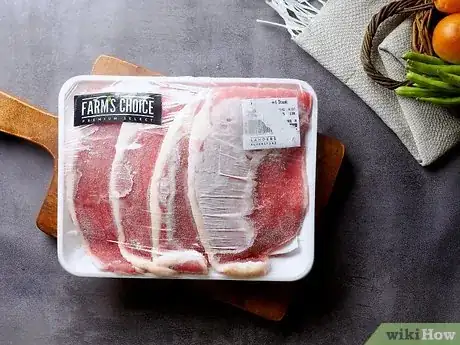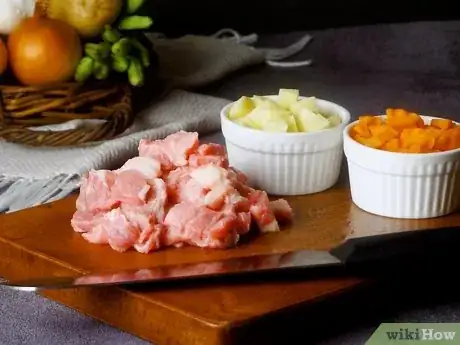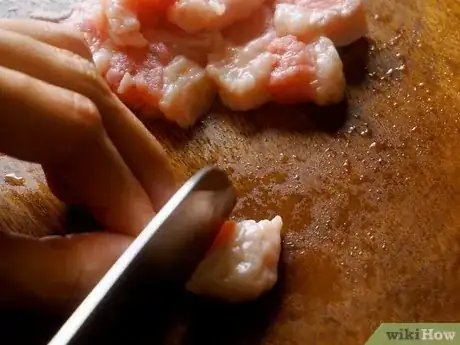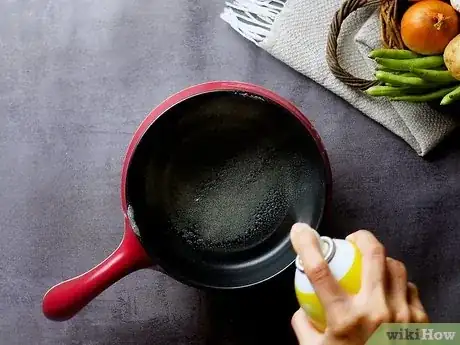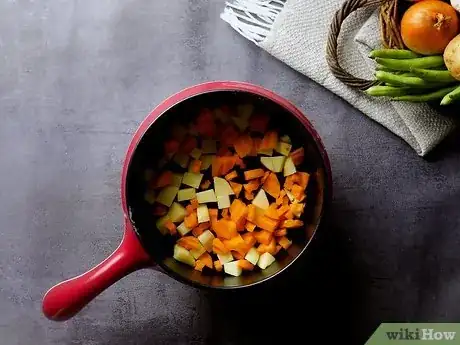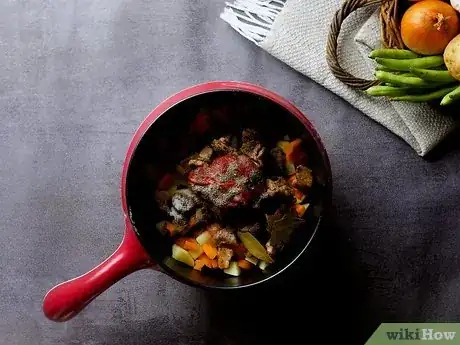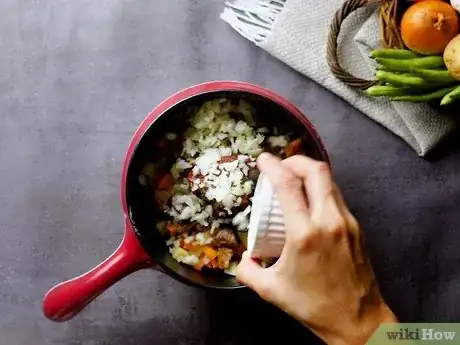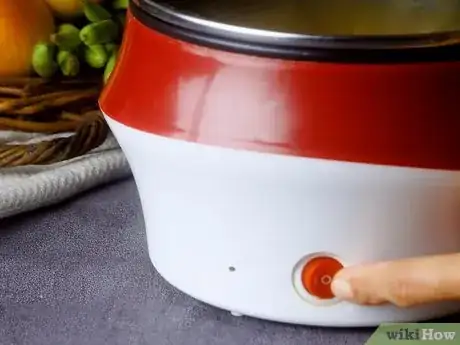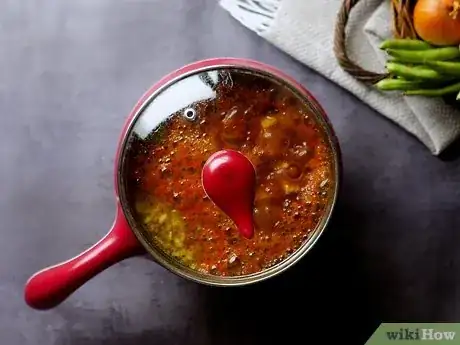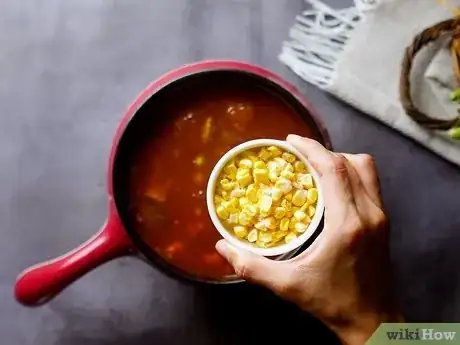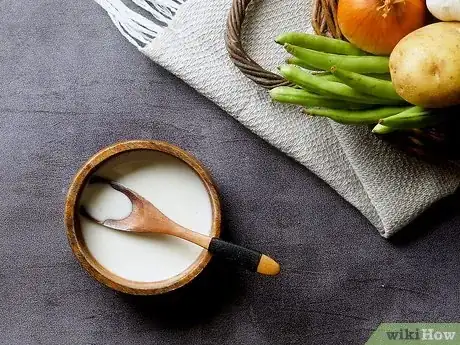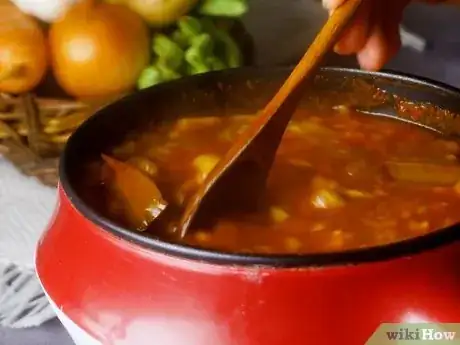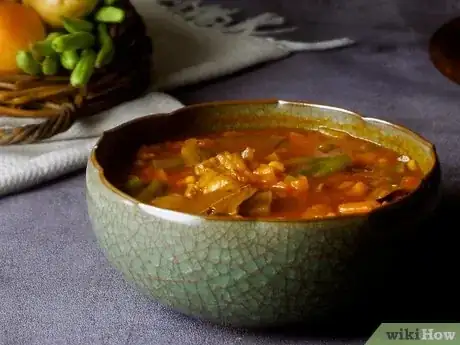wikiHow is a “wiki,” similar to Wikipedia, which means that many of our articles are co-written by multiple authors. To create this article, volunteer authors worked to edit and improve it over time.
The wikiHow Culinary Team also followed the article's instructions and verified that they work.
This article has been viewed 54,452 times.
Learn more...
Nearly any soup can be prepared in a slow cooker, but the cooking process varies from what you might expect when preparing soup on the stove. Prepare and layer the ingredients in the best possible way to ensure even cooking, and add each ingredient to the soup at the right time to prevent common mishaps.
Steps
Part One: Prepare Your Ingredients
-
1Thaw your ingredients. If any of your ingredients are frozen, thaw them before you start to assemble the soup.
- Place the frozen ingredients in your refrigerator and allow them to thaw slowly overnight.
- If you need to quickly thaw ingredients, do so by using the "defrost" setting on your microwave. Avoid thawing certain ingredients, like meat, at room temperature since doing so provides more opportunity for bacteria to grow.
-
2Cut your ingredients into even pieces. Most of the meat and vegetables should be cut down to similar sizes. Ingredients cut to an even size will cook at the same rate, so they should all reach the right consistency at the same time.[1]
- It is especially important to cut each particular ingredient into evenly sized pieces. In other words, if you cut some of the meat into 2-inch (5-cm) pieces, you should cut all of the meat into 2-inch (5-cm) pieces. If you cut some of the potatoes into 1-inch (2.5-cm) cubes, you should cut all of the potatoes into 1-inch (2.5-cm) cubes.
- Note that aromatic vegetables (like onion and garlic) and soft vegetables (like corn and peppers) can be cut into smaller pieces than the meats and hearty root vegetables. Aromatic ingredients can enhance the flavor more thoroughly if they cook faster than the rest of the soup, and soft vegetables are usually added later in the cooking process, so they won't be cooking for quite as much time as their heartier counterparts.
Advertisement -
3Trim the fat. Consider trimming away the visible, separate layers of fat on any meat you plan to use for your soup.[2]
- Since melted fat has nowhere to drain in a slow cooker, it tends to pool in layers at the top of the soup. A little interior fat can enhance the flavor of the soup, but too much fat can make the broth seem greasy.
- For the same reason, you'll also want to avoid adding any oil, butter, margarine, or lard to the soup ingredients in the slow cooker.
-
4Brown the meat. While not strictly essential, browning your meat in a skillet before adding it the to slow cooker can enhance both the color and flavor of the dish.
- Use roughly 1 to 2 Tbsp (15 to 30 ml) of oil, butter, or margarine for every 1 lb (450 g) of meat. Heat the fat in a nonstick skillet over medium-high heat, then toss in the cut portions of meat and cook, stirring frequently, until the meat looks evenly browned.
- If desired, you can also brown aromatic vegetables beforehand to enrich the flavor profile of the soup. Common aromatic vegetables include onions and garlic.
- When you're running short on time, however, you do not need to brown the meat beforehand. The soup should cook perfectly fine even if you skip this step, but the flavor and color of the finished soup will vary slightly.
Part Two: Start the Soup
-
1Line the slow cooker. Before adding any ingredients, consider covering the bottom and sides of the slow cooker with nonstick cooking spray or a specially designed slow cooker liner.
- This step is not strictly necessary, but lining the slow cooker should prevent ingredients from sticking as they cook, making the cleanup process much easier as a result.
- Slow cooker liners are your best option since they don't introduce any extra fat into the soup. If you choose to use nonstick cooking spray, only apply a light coat and wipe away any pools of fat before adding your soup ingredients.
-
2Put in the heartiest vegetables. Layer all root vegetables on the bottom of the slow cooker before adding any other ingredients.[3]
- Since the heating element of the slow cooker is located at the bottom of the machine, the ingredients that require the longest cooking time should always be placed on the bottom of the slow cooker, where they can get more direct access to the heat. Layering the ingredients like this will help promote even cooking.
- Of all possible soup ingredients, root vegetables usually require the greatest amount of time, so they need to be added first. These ingredients include potatoes, yams, carrots, radishes, parsnips, beets, rutabagas, and large wedges of onion. Winter squashes should also be layered near the bottom of the slow cooker, even though they aren't root vegetables.
-
3Add the meat and desired spices. Most raw meat should be layered on top of the hearty vegetables. Many spices and herbs can be added at this time, as well.
- Fish and other types of seafood should not be added this early, but all other raw meats can be. This includes cuts of beef, chicken, pork, lamb, venison, and goat.
- If you're using previously cooked meat, do not add it to the raw ingredients yet.
- By adding the seasonings early on, you allow their flavors to distribute more evenly throughout the soup broth. Note that rosemary can become bitter when cooked for long periods of time, however, so you should save any rosemary you plan on adding for later. All other herbs and spices can be added now.
-
4Layer on less hearty vegetables. Hard vegetables that aren't quite as hearty as your root vegetables should be layered on top of the meat.
- This can include chopped onion, chopped garlic, tomatoes, chopped celery, cauliflower, and broccoli. All of these vegetables will hold their form when cooked for long periods of time, but since they don't require quite as much heat as meat or root vegetables, they should be placed further away from the lower heating element.
-
5Pour in the broth. Any broth, stock, or water called for in the recipe should be added now. Pour the liquid into the slow cooker, covering the solid ingredients by roughly 1/2 inch (1.25 cm).
- Traditional soup recipes prepared on the stove will usually require much more liquid, but for slow cooker soups, you should only add just enough liquid to barely cover the ingredients. Liquid won't evaporate in a slow cooker like it does in a stockpot, so if you add too much now, the finished soup might be too watery.
- Note that dairy-based liquids should not be added to the slow cooker yet.
-
6Cover and cook. Place the lid on your slow cooker and turn on the heat. Most soups should cook on high for three to four hours or on low for six to eight hours.[4]
- For vegetable soups that do not include any meat, reduce the cooking time. Vegetable soups should cook on low for two to four hours or on high for one to two hours.
- When possible, cook soups on low heat. A lower, slower cooking experience will make your ingredients more tender and allow the flavors to blend more evenly, thereby enhancing the overall taste of the soup.
Part Three: Add the Final Touches
-
1Leave it alone. Allow the soup to cook in the slow cooker without disruption. Do not remove the lid to stir the contents or otherwise check on the ingredients.
- Each time you remove the lid, you'll end up releasing some of the heat. If you remove the lid too often, you'll need to increase the cooking time.
- Only remove the lid if you are adding more ingredients or if the soup is done and ready to serve.
-
2Add quick-cooking ingredients near the end. Some ingredients cook much faster than others, so you should wait until the final 30 to 45 minutes before adding them. After adding these ingredients, return the lid to the slow cooker and continue cooking until done.
- If you add soft ingredients too soon, they will likely become mushy and may fall apart. Such ingredients include soft vegetables (peas, corn, bell peppers, and greens), seafood (fish and shrimp), and grains (rice and pasta).
- Precooked meats should also be added near the end. Adding them sooner shouldn't cause the meat to dry out, but it may cause the meat to fall apart.
- Dairy products must be added during the final portion of cooking, too. This includes cream, milk, shredded cheese, sour cream, cream cheese, and non-dairy milk (like coconut milk or soy milk). Adding dairy too early can cause it to curdle.
-
3Thicken as desired. If you need to thicken the soup broth, you can do so by adding a cornstarch paste during the final 10 to 15 minutes.
- The liquid will not thicken on its own in a slow cooker. This isn't an issue for most soups, but it can be a problem if you prefer soups with a thicker liquid.
- Mix 1 to 2 tsp (5 to 10 ml) of cornstarch with equal parts cold water in a small dish. Add the paste to the contents of the slow cooker, stirring thoroughly to blend it in. Return the lid and continue cooking for another 10 to 15 minutes.
-
4Reduce the liquid as needed. If you accidentally add too much liquid to the soup, you can partially reduce the amount by removing the lid and allowing the soup to sit for another 30 minutes.
- Once you remove the lid, some of the liquid will be able to evaporate. Keep the heat on to maximize possible evaporation and to keep the soup hot.
- The ingredients will not cook as well with the lid removed, though, so you should wait until all of the ingredients are fully cooked before doing this.
-
5Stir and serve warm. Once the soup has finished cooking, turn off the heat, remove the lid, and stir the ingredients to distribute them evenly throughout the soup. Serve the soup directly from the slow cooker while it is still hot.
- Note that some slow cookers have a “warm” setting. If you plan on returning for seconds later on, you can switch the slow cooker to “warm” instead of turning it off completely.
- Typically, extra soup can be ladled into airtight containers and stored in the refrigerator for a few days to a week.
-
6Finished.
Community Q&A
-
QuestionIs the stock to be added hot or cold?
 Community AnswerYou can add the stock hot or cold, depending what you have. Adding hot stock warms up the other ingredients faster.
Community AnswerYou can add the stock hot or cold, depending what you have. Adding hot stock warms up the other ingredients faster.
Things You'll Need
- Slow cooker
- Kitchen knife
- Nonstick skillet
- Slow cooker liners or nonstick cooking spray
- Ladle
- Serving bowls and spoons
References
About This Article
To make soup in a slow cooker, start by preparing your ingredients. If you are using frozen ingredients, make sure to thaw them before you assemble your soup. Next, cut any meats and hearty root vegetables you are using into similar sized pieces so they all cook at the same rate. Aromatic vegetables, like onion and garlic, and soft vegetables, like corn and peppers, can be cut into smaller pieces. If you are using meat in your soup, do the extra step of trimming the fat, then brown your meat in a skillet to enhance the color and flavor. Before adding any ingredients, line the slow cooker with nonstick cooking spray, then add your hearty vegetables. Next, add any meat you are using, along with your desired seasonings. Top it off with your aromatic vegetables. Pour in broth or water until all of your ingredients are covered by roughly 1/2 inch (1.25 cm). Place the lid on your slow cooker and turn on the heat. Generally, most soups should cook on high for three to four hours, or on low for six to eight hours. Do not disturb your soup while it is cooking. Once your soup is finished, turn off the heat, carefully remove the lid, and stir the ingredients to distribute them evenly throughout the soup. Serve warm and enjoy!
